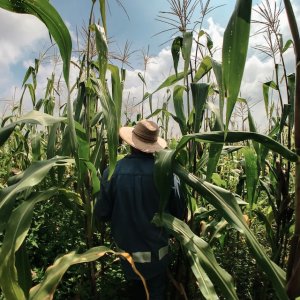Crickets: A Sustainable Food Source with High Social Impact

STORY INLINE POST
We have seen that edible insects are part of the diet in a number of countries, such as chapulin (grasshopper) tacos in Mexico and fried beetles as snacks in Ecuador. But have you ever wondered about the nutritional benefits of edible insects? Edible insects are considered superfoods because they are a high source of low-fat protein, and have a high percentage of amino acids, minerals, and vitamins compared to any conventional animal source. "Insects are a good source of energy, protein (20-70 percent of raw protein), fat (10-50 percent) and essential minerals and vitamins for human nutrition,” according to the World Health Organization (WHO) in 2010.
The nutritional value depends on how the edible insect is raised, prepared or mixed with other ingredients to develop healthy products. Crickets, edible insects, have high fiber levels, nine amino-acids, vitamin B12, calcium, iron, and omega 6. Some companies within the market sell dehydrated crickets as a snack rather than ground crickets. Crick Superfoods, an Ecuadorian startup that uses cricket protein powder as part of its product formula, offers the market high-protein, low-fat, gluten-free products: nachos, tortillas, and crunchy toppings.
Today, consumers are more responsible and look for food brands with a positive environment and social impact. Crickets are sustainable protein because they pollute less than any protein of animal origin in terms of the use of space, water, and CO2 emissions. Thus, they are a healthy alternative for developing muscle mass and for digestion. The Food and Agriculture Organization of the United Nations (FAO) determines that crickets benefit muscle mass. “[...] 1 kg of live animal weight in a typical United States production system requires the following amount of feed: 2.5 kg for chicken, 5 kg for pork, and 10 kg for beef. Insects require far less feed. For example, the production of 1 kg of live animal weight of crickets requires as little as 1.7 kg of feed.” (Collavo et al., 2005 cited by FAO, 2013) Therefore, it can be established that crickets can convert food into protein 12 times more efficiently than cows. When crickets are slaughtered, they do not require so much food to maintain their body temperature because they are cold-blooded. The production of cricket protein powder is based on dehydration and grounding. When crickets are grounded, it is used the entirety exoskeleton, respiratory linings, digestive and excretory systems, where the chitin is located. “Insects also contain relevant levels of crude fiber, most predominantly in the form of chitin, derived from the exoskeleton. A recent estimate of chitin and chitosan-based on percent dry weight of whole ground crickets found values between 4.3–7.1% and 2.4–5.8%, respectively.” (Stull, Finer et al., 2017) Chitin has an insoluble fiber with potential prebiotic properties that benefit human health. Crickets support the growth of beneficial bacterial species in the intestines, called probiotics. They make crickets 80 times more digestible than red meat consumption. Crickets also produce lysine, threonine, and methionine, amino acids that are limited in some legumes and cereals.

Insects are an important source of protein, probiotics and fiber for human nutrition. Taking all those nutritional advantages, some startups use cricket protein powder as one of the main raw materials for developing high protein products without whey, which has an environmental impact from cattle. For example, Crick Superfoods does not sell dehydrated cricket as a snack. During the market research process, some interviewers got a leg or a wing, and even a sore throat after eating them. Likewise, the start-up is located in Ecuador, a country where crickets are not a traditional edible insect. It was not an option to present the cricket itself to the consumer. We constantly review two important aspects of the consumer experience: taste and the visual presentation. On the flavor side, we make sure that the flavor is similar to any other product from the same category as our associative memory remembers it. In terms of presentation, we make sure that no trace of the cricket is found.
After one year of research and nine months into the market, Crick Superfoods offers three different products: high-protein nachos, healthy tortillas and crunchy. Our high-protein cricket nachos are made with bean flour because it can “reduce stunting in high-risk children because of the protein and micronutrients [reduce] enteropathy, or inflammation of the intestinal lining, can decrease nutrient absorption and contribute to stunting.” (FAO, 2016) Beans are an excellent source of zinc, folate, magnesium, and iron, preventing anemia and producing red blood cells. Being conscious of the environmental impact, Crick Superfoods also is aware of food waste. From that, we launched crunchy high-protein toppings. These are shredded from those nachos that do not comply with the quality process in size. By launching this product, we opened the possibility for it to be used in crispy recipes such as mozzarella sticks, chicken fingers, or chicken wings, or added as toppings for salads. Our third product, healthy tortillas, are based on cricket protein powder and made of black corn or yellow corn and amaranth protein. “[Amaranth] produces serotonin, the “feel-good” brain chemical that elevates mood, suppresses appetite, and has a calming effect.” (Ricks, 2014:2) Amaranth has a low glycemic index. It lowers blood pressure that benefits people with diabetes or hypertension.
Despite these advantages, consumer acceptance remains one of the largest barriers to adopting edible insects in the daily diet. Intensive animal production with high densities of animals is a starting place for many significant health issues. It is important to determine the origin and the impact of our food. Moreover, crickets have a different composition than other edible animals because they combine a source of energy, are low in fat, and have amino acids and vitamins. Are you still worried about eating edible insects? If your answer is yes, you could compare the nutritional and environmental advantages of crickets or any other edible insect to other animal protein. If you still have doubts, you can consume processed products from Crick Superfoods based on cricket protein powder, letting you forget that you are eating insects. If your answer is yes, we invite you to share all this information to break the misinformed taboo of consuming insects and become part of this new movement to save our planet through food consumption.
























